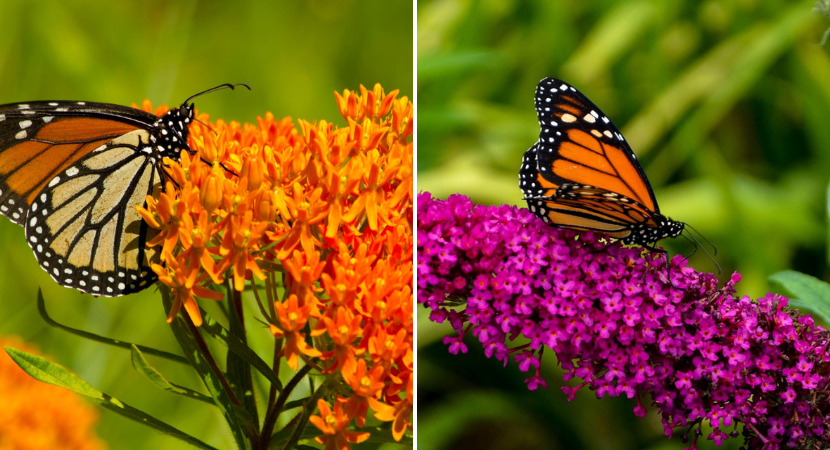Bringing butterflies to your garden isn’t just about adding visual charm; it’s also about fostering a thriving ecosystem. By planting specific flowers, you can create an environment that entices these colorful insects. Butterflies not only enhance the beauty of your garden but also play a crucial role in pollination. Here, we explore ten plants renowned for their ability to attract butterflies, adding vibrancy and life to your outdoor space.
1- Butterfly Bush (Buddleja davidii)
As the name suggests, the butterfly bush is a favorite among butterflies. Its long, fragrant flower spikes produce abundant nectar, attracting various species such as admirals, fritillaries, and swallowtails. This fast-growing shrub is easy to care for and blooms profusely throughout the summer, creating a spectacle while providing sustenance for butterflies.
2- Milkweed (Asclepias):
Milkweed is essential for attracting monarch butterflies, serving as the sole host plant for their caterpillars. Varieties like Asclepias tuberosa and Asclepias incarnata produce vibrant blooms that offer nectar for adult butterflies. By including milkweed in your garden, you provide crucial support for monarch populations while enjoying the sight of these majestic creatures.
3- Lantana (Lantana camara):
Lantana’s clustered flowers come in a range of hues, from red and orange to yellow and purple, making it a visual delight in any garden. Its nectar-rich blooms are particularly attractive to swallowtails and painted ladies. Thriving in sunny locations with well-drained soil, lantana adds both beauty and functionality to butterfly gardens.
4- Purple Coneflower (Echinacea purpurea):
The purple coneflower’s daisy-like blooms with spiky centers are not only visually appealing but also highly attractive to butterflies. By planting this perennial in your garden, you provide a vital food source for butterflies while adding a touch of elegance to your landscape. Leaving the spent flower heads intact can also attract goldfinches, further enriching your garden’s biodiversity.
5- Verbena (Verbena bonariensis):
Verbena’s slender stems and delicate flowers make it a favorite among butterflies. Its long blooming period ensures a steady supply of nectar throughout the season, attracting various butterfly species. Whether planted in borders or containers, verbena adds grace and movement to any garden while supporting butterfly populations.
6- Zinnia (Zinnia elegans):
Zinnias are beloved for their bright, colorful blooms and easy cultivation. These annual flowers provide abundant nectar for butterflies, making them a valuable addition to butterfly gardens. With their cheerful appearance and long-lasting flowers, zinnias bring joy to both gardeners and butterflies alike.
7- Black-eyed Susan (Rudbeckia hirta):
Black-eyed Susans are cherished for their cheerful yellow flowers with dark centers. These hardy perennials attract butterflies with their nectar-rich blooms, serving as important food sources. Additionally, black-eyed Susans are drought-tolerant and low-maintenance, making them perfect for gardeners seeking to attract butterflies with minimal effort.
8- Aster (Symphyotrichum):
Asters are late-season bloomers that provide essential nectar for butterflies as other flower sources decline. Their daisy-like flowers come in various colors and sizes, attracting butterflies such as monarchs, sulfurs, and skippers. Planting asters ensures a reliable food source for butterflies well into the fall, extending the duration of butterfly activity in your garden.
9- Salvia (Salvia):
Salvias, also known as sages, are prized for their aromatic foliage and vibrant flowers. Varieties such as Salvia nemorosa and Salvia leucantha produce spikes of tubular blooms that are irresistible to butterflies. These drought-tolerant perennials thrive in sunny locations and provide valuable sustenance for butterflies throughout the growing season.
10- Phlox (Phlox paniculata):
Phlox’s fragrant, showy clusters of flowers make it a standout in any garden. Its nectar-rich blooms attract a variety of butterflies, including swallowtails and skippers. With its long blooming period and wide range of colors, phlox adds beauty and biodiversity to butterfly gardens, enriching the landscape with both visual appeal and ecological value.
Conclusion:
By incorporating these ten plants into your garden, you can create a haven that attracts and sustains butterflies throughout the seasons. From the early blooms of butterfly bush to the late-season flowers of asters, each plant offers unique benefits for both butterflies and gardeners. By supporting butterfly populations, you not only enhance the beauty of your garden but also contribute to the health of local ecosystems. So, roll up your sleeves and plant a butterfly-friendly garden that will bring joy to both you and these enchanting winged creatures.
